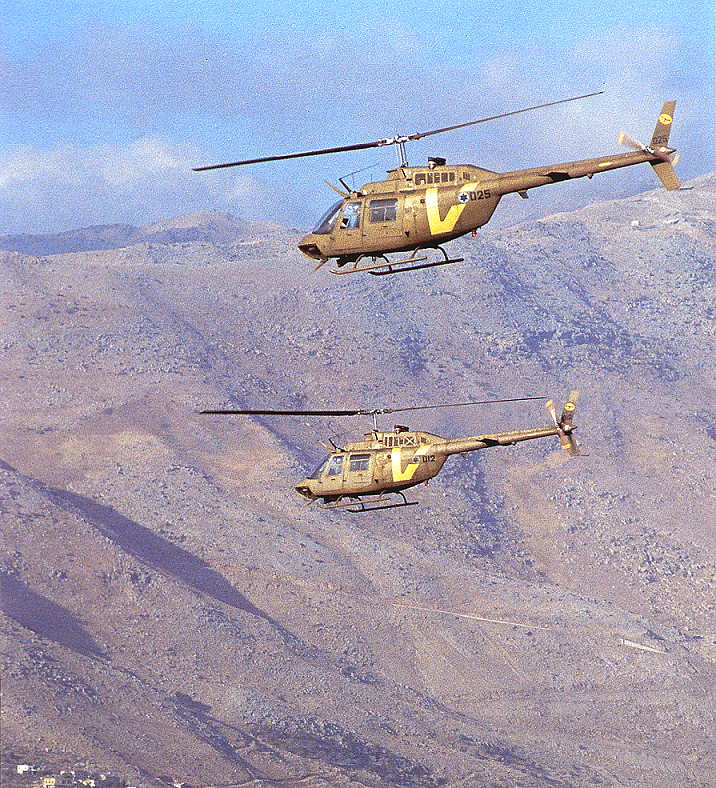
The Bell 206A JetRanger was developed in response to a US Army requirement for a light observation helicopter. Although loosing the US Army contract to Hughes, Bell nonetheless built a five seat prototype of its aircraft, flown on January 10th 1966 and certified nine months later. The Model 206A was soon produced commercially and enjoyed massive success with both civilian and military operators around the world. The capacity and reliability of the JetRanger family resulted in Bell developing a medium-lift version of the 206 designated Model 206L LongRanger, incorporating a stronger engine, a lengthened fuselage and a larger-diameter main rotor.
The IAF had begun operating light helicopters in the mid 1950s but it was not until the Six Days War of 1967 that their importance was fully appreciated. The war had displayed the helicopter's advantages in the light transportation, VIP transport, liaison and recon roles, and in its aftermath a new light helicopter squadron was set up, the 125th "Hamesokim Ha'Kala" (Light Helicopters) squadron. At first equipped with the Aerospatiale Alouette II, the new squadron was based at Sde Dov. The Alouettes, however, were aged aircraft, lacking night flying capabilities, and the IAF sought to purchase another, more capable type. After testing a number of helicopters, including the Hughes OH-6A and the MBB BO-105, the IAF finally selected the JetRanger as its next light helicopter. The first two IAF JetRangers arrived in Israel in June 1971 and the type was nicknamed "Saifan" (Avocet).
When the Yom Kippur War broke out in October 1973, the 125th sqn. dispersed its aircraft to the various fronts, setting up a number of independent sections to operate alongside Israeli ground forces. Besides their regular role as light transports and VIP helicopters, the Saifans were also employed for casualty evacuation and pursuit of enemy forces. Another new role adopted during the war was artillery targeting, the helicopters directing Israeli ground fire against enemy positions. On one such mission eight Egyptian soldiers surrendered to a Saifan after an officer on board spotted and opened fire on them.
Cooperation with IDF ground forces continued after the end of the Yom Kippur War and the roles played during the war were now integrated into the squadron training regime. The end of the war also brought about an increase in American military assistance to Israel and more aircraft were procured. The increased Saifan numbers allowed the type's introduction into the IAF Flight School and since May 1976 the type has been the primary trainer for all future IAF helicopter pilots.

The Bell 206s were back in action during operation "Peace For Galilee", the 1982 invasion of Lebanon. During the war the 125th sqn. operated a temporary section at the northern airfield of Mahanaim, flying liaison, reconnaissance, transportation and evacuation duties in support of Israeli forces. These flights continued long after the end of hostilities, supporting the Israeli presence deep inside Lebanon. While Israel withdrew from most of Lebanon in 1985, it had nonetheless set up the southern Security Zone to protect its northern border from attacks originating there. Saifans continued to provide assistance to Israeli forces in Lebanon right up to Israel's withdrawal in May 2000. For their missions inside Lebanon, the helicopters were equipped with self-protection suites to guard against enemy ground fire.
Unlike most other elements of the IAF, Bell 206s saw extensive service during the Intifada, the Palestinian uprising which begun in December 1987, flying policing duties for the IDF. The Saifans also saw a great deal of action during the 1991 Gulf War. Every time Iraqi Scud missiles were launched against Israel, Saifans were scrambled to locate the point of impact, to determine whether the missile contained a chemical warhead and to direct search and rescue forces to the spot. The fear of Iraqi chemical warfare meant that the pilots manning these missions were ordered to fly wearing gas masks. On January 13th 1994 a Saifan on approach to an army base near Jerusalem collided with an antenna, killing to two pilots and two other officers on board, including the commander of Israel's Central Command.
May 1984 witnessed the introduction of another Bell 206 variant into IAF service, the 206L LongRanger, nicknamed "Saifaneet". The Saifaneet, capable of carrying 5 passengers instead of the Saifan's 3, is operated by the 125th squadron alongside the Saifans, flying similar roles. Its first trial by fire came during the April 1996 campaign against Hizbullah guerrillas in southern Lebanon, operation "Grapes of Wrath".
The 125th sqn. continues to be the IAF's primary VIP transport squadron, regularly flying high ranking officers all over Israel. Operating the Saifan and Saifaneet, it has become the largest squadron in the IAF, in both men and aircraft.
 back to the IDF/AF page
back to the IDF/AF page